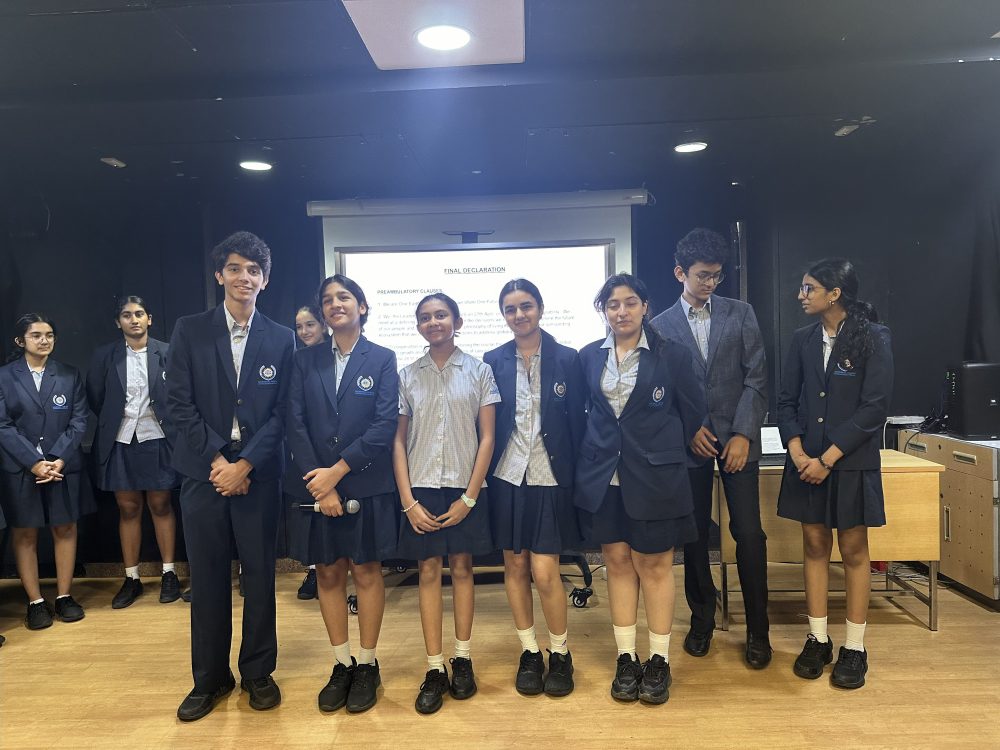
From D20 to SIC: Students Driving Sustainable Innovation at DAIS
The D20 Summit at Dhirubhai Ambani International School in India began as a small idea from six students. Fresh from attending a G20-inspired student conference at Mayo College, they returned energised by the spirit of collaboration and action they had witnessed.
“We really felt like we had a voice,” said one of the founding organisers. “It wasn’t like Model UN, which is often more about debate and individual speeches. This was about finding common ground.”
Determined to recreate that experience at home, they designed and delivered their own version of the G20—scaled down, but just as purposeful. D20 became a student-led intra-school conference for Grades 6 to 8, with each delegate representing a country and joining one of three committees: Environment, Finance, or Sherpa (working across the others to support consensus-building).
What set D20 apart was its collaborative structure. “Most conferences like MUN keep committees separate,” explained one participant. “But we recognised that every global issue is connected, and so should the solutions be. Finance had to talk to Environment. Sherpas brought everyone together.”
The summit was anchored in diplomacy and empathy, with chairs trained to handle disagreements constructively. “We practised how to navigate conflict, how to ask the right questions, how to listen,” said one chair. “It was about creating a space where everyone’s voice mattered, and where difference did not mean division.”
Running alongside the summit was the Sustainable Innovation Challenge, where students pitched tech-based solutions to environmental problems they identified around the school. Ideas included producing clean methane from food waste to fuel school buses and designing an AI prototype for water efficiency. “It was amazing to see what they came up with in just half an hour,” reflected a student leader.
Both initiatives formed part of a broader Earth Day capsule at DAIS. “It was exciting because it was ours,” said one of the students who helped create the event. “We designed it, we led it, and now we want to grow it.”
And grow it they did.
This year, the initiative evolved into SIC (Sustainable Innovative Solutions), expanding beyond DAIS to welcome students from six other schools. In alignment with the UN Earth Day theme, “Our Power, Our Planet”, SIC encouraged participants to use technology to design real-world solutions with a particular focus on renewable energy.
Celebrations spanned Earth Week from 21 to 28 April, involving DAIS, NMAJS and EYC. Student volunteers from Grades 6 to 11 curated interactive experiences to demystify environmental concepts for different age groups, from renewable energy and fossil fuel dependency to energy conservation. The aim was not only to build awareness but also to empower students to take responsibility for how energy is used and to think creatively about future alternatives.
“The objective was the same as before: real-world problem solving,” explained a student volunteer. “But this year, it was on a bigger scale, with more voices, more ideas, and more opportunities to collaborate.”
From a spark of inspiration in six students to a multi-school event aligned with global sustainability goals, the D20’s trajectory into SIC demonstrates the power of youth-led action. It reflects the ethos at DAIS: to inspire young people to see themselves as changemakers, working together towards a more sustainable future.
How to Run a D20 Summit: A Step-by-Step Guide
1. Understand the Inspiration:
The D20 Summit was inspired by the G20 conference that students attended at Mayo College, where 20 countries come together to make the world a better place. The goal is to give students a voice on global issues in a collaborative setting, different from typical Model UN formats.
2. Define Committees and Delegations:
Organise the summit with three main committees:
- Finance Committee
- Environment Committee (example: headed by Kavya)
- Sherpa Committee (coordinates delegates across committees)
Each committee has 20 delegations. Each student is appointed a country delegation.
3. Structure the Collaboration:
Students research their assigned countries and the key issues related to their committee. During the summit, students discuss and debate policies that their countries might implement to address global issues. The Sherpa Committee coordinates to find common ground between committees.
4. Prepare Chairs and Participants:
- Chairs should be trained to handle any conflicts or disagreements between delegates.
- Students prepare by researching their topics and practicing questions and challenges they might face during the conference.
- Regular rehearsals and discussions among participants help simulate the flow of the conference.
5. Encourage Respectful and Diplomatic Dialogue:
Students learn to express diverse opinions respectfully and diplomatically, keeping the focus on collaboration rather than confrontation. For example, the G20 excluded sensitive conflicts like the Russia-Ukraine war to maintain productive discussions.
6. Integrate with Larger School Initiatives:
The D20 Summit is linked with the school’s Earth Day celebrations and sustainability challenges to promote environmental stewardship. For example, the Sustainable Innovation Challenge invites students to develop technological solutions for real-world environmental issues.
7. Focus on Diversity and Inclusion:
The summit includes students from grades six to eight, encouraging a mix of ages and perspectives. Students learn to navigate differences in opinion and culture to reach consensus.
8. Host the Event Within the School:
Start with an intra-school conference to test and refine the format before expanding. The event can be hosted in one area of the school, with committees collaborating actively throughout the day.
9. Facilitate Cross-Committee Collaboration:
Unlike other conferences where committees work separately, the D20 Summit brings all committees together to recognise that global problems are interconnected, and solutions need to be coordinated across different sectors.
10. Reflect and Scale Up:
After the event, reflect on successes and challenges, and plan to scale the summit by including more schools or expanding the event’s scope.
